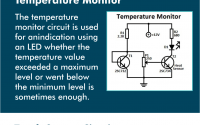Infographics : 8 Techniques to Troubleshoot Your Electronics Circuit
Troubleshooting of an electronic circuit is a process of having a special outlook on components that comes out with remedies to repair it. The unexpected behavior exhibited by the circuit is due to improper locating or soldering of components, component damage due to aging, faults, overheat, and so on. Such a type of behavior can cause undesired results or even circuit damage.
Therefore, these unexpected results of the electronic circuit may require some troubleshooting and testing procedures for making it a ready to use project. It is very common for the hobbyists and circuit designing learners to anticipate the desired or actual results after completion of the circuit at once. The best way to become proficient in troubleshooting even to tackle difficult electronic problems is decided by hands-on experience with the electronic circuits.
Troubleshooting is the process that determines the cause of the problem in the electronic circuit by examining the affected area of it, and then by taking appropriate action. For minor problems, troubleshooting requires a little knowledge about the circuit and its components’ working because it involves checking the connections only. However, the major problems of these circuits require a deeper knowledge of the circuit operation and the way of using various troubleshooting tools.
Therefore, this infographic is presented to provide major steps of troubleshooting, which are helpful for beginners and students. Hope this information certainly gives a chronological way of troubleshooting technique and further any help regarding this concept you can reach us by commenting in the comment section provided at the end of this article.
Note: Some safety and precautionary measures must be taken to prevent the shocks against the live circuits before starting to do the troubleshooting process.
Do You Recognize the 8 Techniques to Troubleshoot Your Electronics Circuit?
Troubleshooting is a technique used for tracing out, identifying, and fixing the most common problems that occur in an electronic circuit, resulting in its malfunctioning.
Confirm the Problem in the Circuit
Start the troubleshooting process only after confirming the problem in the circuit, which may be about the desired results or improper working conditions of the circuit.
Consider Visual Inspection First
This step might be involved in getting physical contact with the circuit. So it is better to remove the power supply to the circuit and wait for some time to discharge current in some components so that you can hold it without fear.
- Check for the exploded or burnt parts of the circuit by seeing and smelling them.
- Look for the loose, bad connections and also check the ground paths.
- Check for the overlapped traces on the PCB.
- Observe the soldered points whether they are correctly soldered or not.
- Check for the shorts or touches on the adjacent soldered points.
Note: If anyone of the above-mentioned conditions requires an immediate repair, then go for the required action like de-soldering the shorted points, soldering the loose parts or the connections, replacing the burnt components with the new ones, etc. If not, it has to be confirmed that the problem in the circuit is a major one, and now you can proceed to go through the below steps.
Select Troubleshooting Tools
Troubleshooting process involves checking the terminal voltage across different components and devices in the circuit; checking the continuity of the current for open circuit faults, components like resistor, capacitor, transistors, and their status checking whether they are functioning or not, and so on. Some of these tools are:
- Digital or Analog multimeter
- Oscilloscope
- LCR meters
- Variable Power supply with a metered indication
Power up the Circuit
Before checking with the above tools, plug the circuit to the main power supply so that it is possible to test it in different ways.
Check the Power Supply Block
Keep the multimeter probes across the transformer, diodes, capacitor, and regulator IC, and check whether appropriate values are found or not by inserting the multimeter in volts mode.
Check the Individual Components
Check the voltage across the individual components, and if any component doesn’t show any voltage across it, then switch off the supply, and then again test the components by respective meters like LCR for the capacitor, diode by multimeter, and so on.
Check the Main Controller
Test the main controller base power supply with respect to the ground without placing a controller on it. And also, check whether some pins are shorted or not for special ICs like timer and Op-Amps – and, for the microcontroller, check respective power supply pins voltage.
Place the ICs on the base, and give the input to the controller, and then check whether the output control signals are coming or not at appropriate pins.
Check the Loads by Metered Power Supply
Check the outputs by removing the main controller like a microcontroller signal to final control devices and apply the metered-power supply so that the problem area can be easily recognized.

Embed This Image On Your Site (copy code below):

